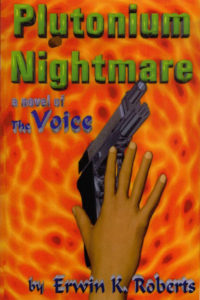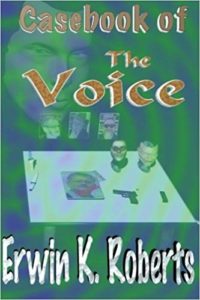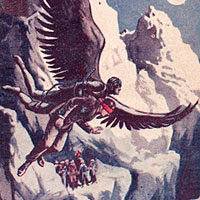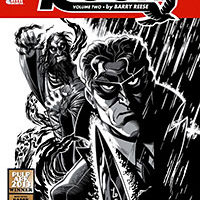 On this blog, I’ve reviewed several works by Erwin K. Roberts: stories of other’s pulp heroes such as Jim Anthony, Dr. Watson, The Green Ghost, The Moon Man, and others; and his two-part The Sons of Thor novella, which includes characters like The Black Bat, The Phantom Detective, and others.
On this blog, I’ve reviewed several works by Erwin K. Roberts: stories of other’s pulp heroes such as Jim Anthony, Dr. Watson, The Green Ghost, The Moon Man, and others; and his two-part The Sons of Thor novella, which includes characters like The Black Bat, The Phantom Detective, and others.
But here I take a look at his own pulp hero: The Voice. I had previously “met” him in The Pulptress, as he was one of her mentors. But now I have read his own stories. Some of these have appeared in various other works, some are original to these collections.
Roberts has put out two volumes (so far) from his own Modern Knights Press: Plutonium Nightmare (volume 1) and Casebook of The Voice (volume 2). A volume 3 is promised, but has yet to appear.
The Voice is an interesting character who is clearly inspired by other pulp heroes. It is not surprising when we learn that he is a fourth-generation hero, and while growing up he had many “uncles” who were various retired heroes, or here called “independent operators.” Clearly, some of those uncles include The Phantom (his son, who is a reporter, does show up in a few stories, and had grown up with him, and the Clarion is mentioned several times), Jim Anthony, and others. It’s not clear who The Voice’s father is. I think it’s The Green Hornet, due to references to newspapers (and his father working on one in retirement) and that The Voice uses a gas gun “like his father.”
The Voice is a master of disguise, similar to Secret Agent X. We never learn The Voice’s real name, and few know what he really looks like. He is a master of armed and unarmed combat, and had fought in the Vietnam War. He is called “The Voice” due to a device that alters his voice. He usually gathers information and passes it along, but when he needs to, he takes action usually with his gas gun and other non-lethal means. But if matters requires it, he will kill. He has a small network of people who can assist him: one aide with technical matters, another with medical. There are a large number of safe houses, but no set “headquarters,” and a specialized van serves as a mobile operations center.
The stories are set in 1970s and ’80s, with hints that he might have retired in sometime in the ’90s. This makes sense as he would have gotten too old for “the game.”
Plutonium Nightmare has two stories. One is the title story, a novel set in 1980, where a group of eco-terrorists steal plutonium from a power plant, but are betrayed by the mastermind behind it, a dangerous character known only as the “Coral Snake.” While The Voice puts an end to the threat, the mastermind gets away. Also included is a short story coda to The Sons of Thor novella, “The Last Son of Thor.”
 Casebook of The Voice has five stories of various lengths: some reprinted, some original. Most of the first stories have a framing device that features a meeting of police chiefs in the midwest in 1999 where they bring a new FBI agent to the area up to speed on “The Voice.” The first, “The Voice of Pain,” is about the aftermath of a kidnapping that went wrong, and The Voice stepped in. The second has The Voice dealing with a bank robbery from the inside. The third is done like a movie script, written by a cop who tells of an encounter he has with The Voice. The fourth has The Voice teaming up with another “independent operator,” one who has interesting abilities of his own. Here they stop a far-right group from bombing the Atlanta Olympics games. The fifth is a long story, which has a new final part here. The Voice goes up against a rich kid who is a sociopath, and The Voice rescues his latest victim. And The Voice deals with his organization, which is operating under the guise of a women’s shelter. (She appears in the first story, so now you know her story).
Casebook of The Voice has five stories of various lengths: some reprinted, some original. Most of the first stories have a framing device that features a meeting of police chiefs in the midwest in 1999 where they bring a new FBI agent to the area up to speed on “The Voice.” The first, “The Voice of Pain,” is about the aftermath of a kidnapping that went wrong, and The Voice stepped in. The second has The Voice dealing with a bank robbery from the inside. The third is done like a movie script, written by a cop who tells of an encounter he has with The Voice. The fourth has The Voice teaming up with another “independent operator,” one who has interesting abilities of his own. Here they stop a far-right group from bombing the Atlanta Olympics games. The fifth is a long story, which has a new final part here. The Voice goes up against a rich kid who is a sociopath, and The Voice rescues his latest victim. And The Voice deals with his organization, which is operating under the guise of a women’s shelter. (She appears in the first story, so now you know her story).
As noted, a third volume is promised, but has yet to appear. I’d love to see it as The Voice is an interesting character. I’d certainly like to know more about him being a “fourth generation” hero. Who are the first, second, and third generations? Are these generations referring to his own family, or a more general reference to groups of heroes emerging. Certainly the implication is that there have been such heroes since after the Civil War. So maybe the first are the dime novel, the secind are the early pulp heroes, the third are the pulp heroes, and the fourth are the post-pulp/New Pulp heroes before 2000. I would certainly like to know who his father is, though understand if it’s more hinted due to copyright issues.
Check out this character. Ask the author to do more. Be nice if Pro Se Press would pick up this character, might get him wider range.




Hi Michael,
Well, finding this link on “Coming Attractions” was indeed a pleasant surprise.
I have been playing with the character who ended up becoming The Voice since my college days in the late 1960’s. Come early 1974 I saw the film “Seven Days In May” for the first time. As the situation with President Nixon got hotter I put the two ideas together. What if somebody decided to try a takeover when Nixon resigned? My character heads for the Pentagon. What he finds is a bunch of his honorary uncles, out of retirement, have beat him there. But, there is not a plot.
BTW, the Clarion newspaper chain is from the Phantom Detective, not the Sentinel.
The third book of the Voice currently stands at about 20,000 words, with 40,000 words to go. As mentioned above, I wrote the Voice’s origin story for Tom Johnson’s “Double Danger Tales” with a framing device. The Voice is laid up. Dana, the girl you mentioned has to take care of him. Every night he tells her a story from his exploits. The second story should appear soon in a project I can’t talk about yet.
Thanks very much for your thoughtful write up!
Best,
Erwin K. Roberts
Right on the newspaper. I had confused the two, but recalled The Voice’s father also worked on one. And the Clarion newspaper was mentioned in the stories. Did a little editing to fix things.
Of course Secret Agent X also used a gas gun, in some of the earlier stories, IIRC.
All of my pulp era fiction assumes that every public domain character shares the same world. That’s why the NY Clarion’s Frank Havens knows Jim Anthony well and nudges Rex Parker (The Masked Detective) in the direction of the Mystery Men.
On the other hand, In “Dawn of the Purple Hoods” Jim Anthony attends the same charity event as the “new young publisher of the Sentinel.” Plus, in “Neighborhood in Peril” Jim meets the elderly owner of the Sentinel named: Dan. Hat tips I’m very happy to include.